This month those of us who work in the search industry, and I suspect more than a few investors, were passing around a cookie string that altered the way Google’s results pages were displayed: 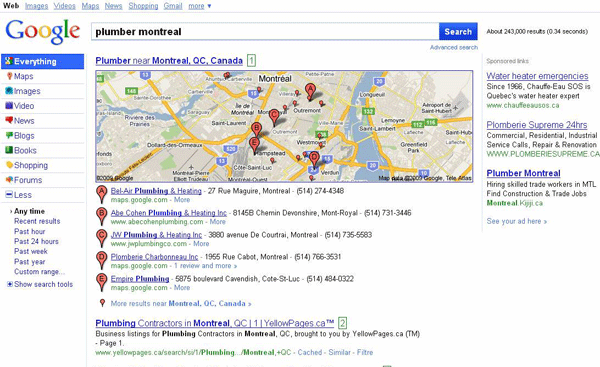 As ugly as it may be to some traditionalists, the three column layout is a more intuitive “web site” shape, and is going to be intuitive to use for a wide variety of users. This push comes from Marissa Mayer at Google, the VP of Search Product and User Experience, as it is outlined by Danny over at Search Engine Land.
As ugly as it may be to some traditionalists, the three column layout is a more intuitive “web site” shape, and is going to be intuitive to use for a wide variety of users. This push comes from Marissa Mayer at Google, the VP of Search Product and User Experience, as it is outlined by Danny over at Search Engine Land.
The party line is that Google wants to test and see if this user experience is well received by the populace at large. If it speeds up the way people complete their search, for instance, it should be weighed as a positive. This potential UI shift is a major departure for Google, and intuitively search marketers and all of their mothers quickly identify this three column Google with the recently revamped competitor, Bing.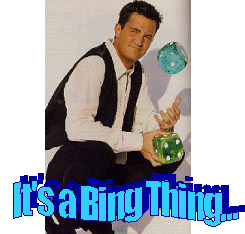 It’s natural for Google to take the competition seriously, and the fact that Microsoft deployed with a left-side navigation means it was tested, and worked. It also was giving MS fodder to differentiate themselves from Google – it helped back up their “decision engine” branding (which I still don’t agree with so much, but if Google makes this change, I may have to eat my words). This left-side navigation, three column layout is also a lot more like a traditional website, and so it is intuitive for everyone – it settles the brain a little, that navigational anchor. Google has thrown so much odd looking junk into their results recently that I think it must be alienating some of the searching population. Those less savvy or comfortable online are going to see universal results and may not know how to react – thinking, ummmm, is this weird stuff more important? Should I be clicking on this? Which could, if not turn them off completely, slow them down by milliseconds – how to speed that back up? Bring the comfort back. Put a left hand column, make it feel like a traditional website so that weird stuff on that part of the screen no longer appears weird, and people get click-happy again. But Google is just testing, albeit with more public relations than they have tested with in the past. Usually the Google search engine results page (SERP) evolves in silence, with little fanfare, after some sample testing has gone on in the background. Google is constantly tinkering, but it seems like sweeping changes have begun to stick a lot more frequently in the past 18 months. Aaron Wall recently wrote to the fact that Google’s brand ownership of the above the fold real estate of their own SERPs can, with certain queries, be ridiculously favoured to something Google owned or related:
It’s natural for Google to take the competition seriously, and the fact that Microsoft deployed with a left-side navigation means it was tested, and worked. It also was giving MS fodder to differentiate themselves from Google – it helped back up their “decision engine” branding (which I still don’t agree with so much, but if Google makes this change, I may have to eat my words). This left-side navigation, three column layout is also a lot more like a traditional website, and so it is intuitive for everyone – it settles the brain a little, that navigational anchor. Google has thrown so much odd looking junk into their results recently that I think it must be alienating some of the searching population. Those less savvy or comfortable online are going to see universal results and may not know how to react – thinking, ummmm, is this weird stuff more important? Should I be clicking on this? Which could, if not turn them off completely, slow them down by milliseconds – how to speed that back up? Bring the comfort back. Put a left hand column, make it feel like a traditional website so that weird stuff on that part of the screen no longer appears weird, and people get click-happy again. But Google is just testing, albeit with more public relations than they have tested with in the past. Usually the Google search engine results page (SERP) evolves in silence, with little fanfare, after some sample testing has gone on in the background. Google is constantly tinkering, but it seems like sweeping changes have begun to stick a lot more frequently in the past 18 months. Aaron Wall recently wrote to the fact that Google’s brand ownership of the above the fold real estate of their own SERPs can, with certain queries, be ridiculously favoured to something Google owned or related: 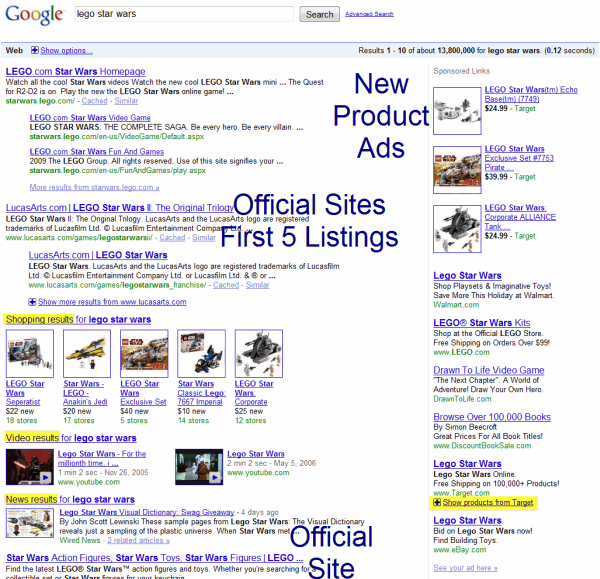 Source: SEO Book When I was a PubCon Vegas the other week I had a chat with the search consultant working with Sony BMG on fixing up half-disastrous major artist sites like MichaelJackson.com and the conversation settled down to the above the fold issue. For a query like “Michael Jackson Movie” he is used to explaining how organic has to compete with a whole heck of a lot of Adwords, but now he has to explain dealing with a gaggle of Google goodies: Google Movies, Google Music, Google News, Mostly Google owned Video results and potentially now, Google Shopping/Product results. It’s clear Google has acquired an appetite for traffic cannibalization of some design. Is it simply an act of brand-building, keeping surfers within their network, or is it a reactionary measure to counter the paranoia induced by virtual-private-internetz like the nemesistic foe Facebook, and those pushing a competing “search product” that is more fully featured? Or is it something broader reaching, something Google feels it needs to do while it has the market share it has now?
Source: SEO Book When I was a PubCon Vegas the other week I had a chat with the search consultant working with Sony BMG on fixing up half-disastrous major artist sites like MichaelJackson.com and the conversation settled down to the above the fold issue. For a query like “Michael Jackson Movie” he is used to explaining how organic has to compete with a whole heck of a lot of Adwords, but now he has to explain dealing with a gaggle of Google goodies: Google Movies, Google Music, Google News, Mostly Google owned Video results and potentially now, Google Shopping/Product results. It’s clear Google has acquired an appetite for traffic cannibalization of some design. Is it simply an act of brand-building, keeping surfers within their network, or is it a reactionary measure to counter the paranoia induced by virtual-private-internetz like the nemesistic foe Facebook, and those pushing a competing “search product” that is more fully featured? Or is it something broader reaching, something Google feels it needs to do while it has the market share it has now? 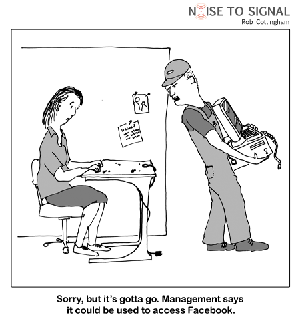 I’m not being conspiratorial here, just contemplative. Google is in a unique position to do user testing on a mass scale rarely seen before, and in an intelligent enough way to draw meaningful results. If Google decides that it should look and act like our opening screenshot implies, you can bet it’s not a whim – but the question is, are they judging their results by positive user impact, or by some internal metric that incorporates things like profitability, or, now that they seem to be running a network of sites, network retention of the surfer? If this is the case positive user impact might be replaced with minimizing negative user impact while increasing profit or retention. This would be much more likely, in Google’s long term planning, to be evaluated as something resembling “user acceptance and adaptation potential”. Google is big. Really, really big. They’re also close to a monopoly in North American search. Although big, North America is a relatively isolated culture – it creates its own trends. Google then, has the opportunity to not only serve a culture’s need for search, but also, at least in part, to define the expectations people have of what they think search results are, or should be. This is a position of unimaginable power, though most people wouldn’t have cause to notice, or in most cases, so long as things don’t change too much, care. People outside of the industries of search marketing, librarianship, ontology and psychology, rarely compartmentalize the concept of “search” as being something people do with intent, develop as a skill, or have defined expectations about while performing.
I’m not being conspiratorial here, just contemplative. Google is in a unique position to do user testing on a mass scale rarely seen before, and in an intelligent enough way to draw meaningful results. If Google decides that it should look and act like our opening screenshot implies, you can bet it’s not a whim – but the question is, are they judging their results by positive user impact, or by some internal metric that incorporates things like profitability, or, now that they seem to be running a network of sites, network retention of the surfer? If this is the case positive user impact might be replaced with minimizing negative user impact while increasing profit or retention. This would be much more likely, in Google’s long term planning, to be evaluated as something resembling “user acceptance and adaptation potential”. Google is big. Really, really big. They’re also close to a monopoly in North American search. Although big, North America is a relatively isolated culture – it creates its own trends. Google then, has the opportunity to not only serve a culture’s need for search, but also, at least in part, to define the expectations people have of what they think search results are, or should be. This is a position of unimaginable power, though most people wouldn’t have cause to notice, or in most cases, so long as things don’t change too much, care. People outside of the industries of search marketing, librarianship, ontology and psychology, rarely compartmentalize the concept of “search” as being something people do with intent, develop as a skill, or have defined expectations about while performing. 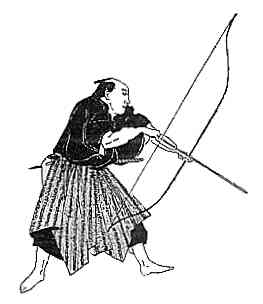 People do, of course, search with intent, some more skillfully than others, and absolutely everyone who has ever used Yahoo! or the like, has expectations as to what will be returned from that tabula rasa come search box. In the search industry there is an old turn of phrase that has evolved its meaning in context as the search results pages have changed: Ten Blue Links. The classic, plain-Jane search results page of ten blue links on a white page form the basic schema upon which western culture has built their expectations of internet based “search results”. I’m not defending it as ideal, just pointing out that it is in fact a schema. It has only been a couple of short years since the most basic experimentation with the classic motif started taking place. Google eventually lost its timidity and started pushing search results changes without any explicit user input (you could always command Google to do things like serve you scraped dictionary results with a “define:” query). Universal search was the public face put to the conceptual change Google had begun instigating. By using it as a publicity vehicle, Google made it more than acceptable for people to expect images and videos in their search results — with a little testing the big G scaled back the concept of actually playing back videos from their search results pages, choosing instead to push people to the video site such as Youtube. The Youtube acquisition also gave Google a chance to peer into their audience a little more, interact with them, learn about them, and it also gave them another taste of the pure
People do, of course, search with intent, some more skillfully than others, and absolutely everyone who has ever used Yahoo! or the like, has expectations as to what will be returned from that tabula rasa come search box. In the search industry there is an old turn of phrase that has evolved its meaning in context as the search results pages have changed: Ten Blue Links. The classic, plain-Jane search results page of ten blue links on a white page form the basic schema upon which western culture has built their expectations of internet based “search results”. I’m not defending it as ideal, just pointing out that it is in fact a schema. It has only been a couple of short years since the most basic experimentation with the classic motif started taking place. Google eventually lost its timidity and started pushing search results changes without any explicit user input (you could always command Google to do things like serve you scraped dictionary results with a “define:” query). Universal search was the public face put to the conceptual change Google had begun instigating. By using it as a publicity vehicle, Google made it more than acceptable for people to expect images and videos in their search results — with a little testing the big G scaled back the concept of actually playing back videos from their search results pages, choosing instead to push people to the video site such as Youtube. The Youtube acquisition also gave Google a chance to peer into their audience a little more, interact with them, learn about them, and it also gave them another taste of the pure 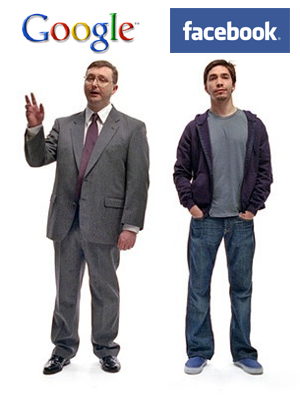 fabled Facebook honey. Remember, this is a Facebook who openly states that they intend to change the way people think of search, by being the first to tie everything to a personal social graph, and bring information and recommendation origins back around, once again closer to home. They also state openly that they plan to beat Google at their own game. Google on the other hand has been busily blossoming our concepts of what search should be by injecting more and different types of content into its search results, and slowly inching closer to people’s personal and social lives. But Google has to decide if they even want to accommodate the mental shift in “what search means” that Facebook wishes to see take place. If anything they aught to be pushing the concept of openness in search, the extended value of crowd-sourced recommendations. There is more information in the wild, and a lot of people don’t have a social graph capable of recommending a new television, or the perfect learning toy for their one year old – but Google does. The simple truth is, however Google decides to alter its results page will *define* how American culture, and perhaps beyond, perceive what a search result should *be*. Recently, Google has been pushing the envelope of what a search result means. In fact, sitting right inside the results pages these day’s are Google’s own personal affiliate links. Google “Product Listing Ads” is Google.com acting like an affiliate site, where they allow you to list your product inventory links much like traditional Adwords ads, but you pay per acquisition instead of per click. The ‘Product Results’ which appear to sit in the right sidebar look a whole heck of a lot like the ‘Shopping results’, in the new way they are constructed and displayed. The interesting bit is that the shopping results appear to be integrated right into the middle of search results pages, an area we have traditionally been conditioned to think of as holding purely organic content. And from where I’m sitting, they’re not clearly labeled as ads if they’re labeled as “Shopping results” and “Product listings”. As Google integrated Universal Search with pictures, videos and news, we thought of it as benignly “organic”, but now it seems it may simply have been softening us up mentally for the introduction of commercial elements into the middle of our classic Ten Blue Links schema – and with Shopping results, Google has taken direct advantage of the natural trust we have in that portion of their SERPs, by integrating images with a simple heading that almost, but not quite, differentiates them as advertising – many of us will take on trust that these are a natural addition to what we, as a culture, have naively been thinking of as purely organic real-estate. Is it an inevitability that we will have to update our old concepts of search to include a continuous commercial slant? Probably. This is all somewhat expected, but one Google test pointed out by Aaron Wall sent more of a chill through my spine than the idea of Surgey Brin, Superaffiliate, and it was this little obfuscation of the URL, replaced with breadcrumbs:
fabled Facebook honey. Remember, this is a Facebook who openly states that they intend to change the way people think of search, by being the first to tie everything to a personal social graph, and bring information and recommendation origins back around, once again closer to home. They also state openly that they plan to beat Google at their own game. Google on the other hand has been busily blossoming our concepts of what search should be by injecting more and different types of content into its search results, and slowly inching closer to people’s personal and social lives. But Google has to decide if they even want to accommodate the mental shift in “what search means” that Facebook wishes to see take place. If anything they aught to be pushing the concept of openness in search, the extended value of crowd-sourced recommendations. There is more information in the wild, and a lot of people don’t have a social graph capable of recommending a new television, or the perfect learning toy for their one year old – but Google does. The simple truth is, however Google decides to alter its results page will *define* how American culture, and perhaps beyond, perceive what a search result should *be*. Recently, Google has been pushing the envelope of what a search result means. In fact, sitting right inside the results pages these day’s are Google’s own personal affiliate links. Google “Product Listing Ads” is Google.com acting like an affiliate site, where they allow you to list your product inventory links much like traditional Adwords ads, but you pay per acquisition instead of per click. The ‘Product Results’ which appear to sit in the right sidebar look a whole heck of a lot like the ‘Shopping results’, in the new way they are constructed and displayed. The interesting bit is that the shopping results appear to be integrated right into the middle of search results pages, an area we have traditionally been conditioned to think of as holding purely organic content. And from where I’m sitting, they’re not clearly labeled as ads if they’re labeled as “Shopping results” and “Product listings”. As Google integrated Universal Search with pictures, videos and news, we thought of it as benignly “organic”, but now it seems it may simply have been softening us up mentally for the introduction of commercial elements into the middle of our classic Ten Blue Links schema – and with Shopping results, Google has taken direct advantage of the natural trust we have in that portion of their SERPs, by integrating images with a simple heading that almost, but not quite, differentiates them as advertising – many of us will take on trust that these are a natural addition to what we, as a culture, have naively been thinking of as purely organic real-estate. Is it an inevitability that we will have to update our old concepts of search to include a continuous commercial slant? Probably. This is all somewhat expected, but one Google test pointed out by Aaron Wall sent more of a chill through my spine than the idea of Surgey Brin, Superaffiliate, and it was this little obfuscation of the URL, replaced with breadcrumbs:  Source: Seo Book If Google is going to take the URL reference away from the SERPs, then they are thinking in broader terms. A lot of content publishers, old school and new, feel threatened by Google co-opting their content, and if Google decides to minimize the importance of the domain name as a reference point for content origin in the SERPs (the domain name is still the main way to brand a business online), then it places further space between what Google wants you to think of as “search results”, and the space in our minds they still own completely, our traditional Ten Blue Links. It’s obvious Google is planning on evolving their results pages, and as they do they will have to match the SERPs to their strategy of how they want users to think of “search results” over the next five years. They have real competition with innovation and deep pockets working at changing the public’s idea of what search means to match their own products, which they’re intentionally differentiating from Google Search. What Google decides to do with their results pages in 2010 may define their short-term future, and may change the way people think about search, fundamentally, over the next few years – but only if Microsoft or Facebook don’t see too much success themselves in the same effort.
Source: Seo Book If Google is going to take the URL reference away from the SERPs, then they are thinking in broader terms. A lot of content publishers, old school and new, feel threatened by Google co-opting their content, and if Google decides to minimize the importance of the domain name as a reference point for content origin in the SERPs (the domain name is still the main way to brand a business online), then it places further space between what Google wants you to think of as “search results”, and the space in our minds they still own completely, our traditional Ten Blue Links. It’s obvious Google is planning on evolving their results pages, and as they do they will have to match the SERPs to their strategy of how they want users to think of “search results” over the next five years. They have real competition with innovation and deep pockets working at changing the public’s idea of what search means to match their own products, which they’re intentionally differentiating from Google Search. What Google decides to do with their results pages in 2010 may define their short-term future, and may change the way people think about search, fundamentally, over the next few years – but only if Microsoft or Facebook don’t see too much success themselves in the same effort.



